The Story of Culture and Arts
- Image resource of Korean history
- Documents from History TextBooks
- Culture & Art Stories from Korean History
- Culture & Art Stories from Korean History - Korean
- National Institute of Korean History
- History net
- About the site
- Introduce
-
Numerous topics related to Korean culture and art are mentioned in middle and high school national history textbooks, but most of them are briefly described by era, making it difficult to understand their concepts, transition processes, and characteristics.
<Culture & Art Stories from Korean History> produces and provides video materials based on expert commentary on the flow, change process, characteristics and characteristics of each major topic in the field of culture and art in Korean history.

Scenario
These days, with advancements in travel and technology, it is now possible to eat a country’s most delicious dishes anytime, anywhere.
However, in the past, when it was difficult to transport and store food, there was a table before “the person with supreme power and dignity” that was set with only the finest fare. This was none other than the king’s table.
The royal dining table, both delectable and majestic.
Let’s learn about “Royal Cuisine”, the dinner table that contained Korea’s own flavors and traditions.
The King Ate not Three Meals a Day, but Five?
When we think of “Royal Cuisine” that was prepared in the royal palaces of the past, we may expect records of this to have been passed down through royal history, from the time of Dangun to the Joseon Dynasty. Unfortunately, records relating to royal cuisine are concentrated in the period after the mid-Joseon Dynasty.
Due to the drought, their majesties the queen dowagers were practicing gamseon (dietary reduction). But as rain has now fallen in sufficient amounts, we request their table settings be restored to the standard number of dishes. - Seongjong sillok (Veritable Records of King Seongjong), Month 5, Day 5, Year 22 of King Seongjong’s reign (1491)
The act of preparing food for a dignified place is called ‘gwe (饋)’. - Gonggwe (Serving food to superiors), from Gyeongguk Daejeon Juhae (Annotated Commentary on the State Code)
Court Food was largely separated into ordinary meals and ceremonial dinners. There were banquets to celebrate royal birthdays or milestones, state dinners to entertain foreign dignitaries, matrimonial banquets for royal weddings, memorial service offerings when memorial rites were performed, and more.
While there are several records detailing formal banquets, such as the Jinyeon Uigwe and the Jinchan Uigwe, there is very little information concerning the daily diet of the royal court. Currently, the only record providing a detailed look at the king’s daily diet is the table setting of King Gojong as passed on through the teachings of a former court lady and the Wonhaeng Eulmyo Jeongni Uigwe from the 19th year of King Jeongjo’s reign. This last record describes the table setting for the 8-day event of King Jeongjo taking his mother, Lady Hyegyeong, to Hwaseong and holding an event there before returning home. It describes in detail both the royal feast and the ordinary meals served.
Send rulers for measuring the height and volume of dishes to every government post station to prepare as guided. - Wonhaeng Eulmyo Jungni Uigwe, “Chanpum” (Inventory of food and materials used in preparation for an event)
The jusura (royal lunch) on the return journey is fish fillet dumplings. - Wonhaeng Eulmyo Jungni Uigwe, “Chanpum,” Josura for Intercalary Month 2, Day 9, Eulmyo Year (1795)
We can’t know for sure what daily meals were like in the palace, but we do know the number of meals held during a royal visit, what food was eaten, the seasonal ingredients available, and the composition of the table setting.
So, what was the typical palace diet like?
By law, the head chef must provide a meal for the king five times a day. - Yeongjo sillok (Veritable Records of King Yeongjo), Volume 127, “Record of Conduct (行狀) of King Yeongjo”
The king’s meals were referred to as “sura” and were held not three times a day, but five. Early breakfast was given at 7 a.m., and consisted of porridge, boiled rice, or other liquid food. At 10 a.m., josura, or breakfast, was held. Between 12 and 1, liquid food again or other light refreshments were served. At 5 p.m. was seoksura, or dinner. And then late at night, he would be given noodles, yaksik, or milk porridge.
The morning and evening sura were strictly prepared according to set rules. Each sura came with a soup, kimchi, and sauces as a base followed by 12 different dishes.
Both white rice and red rice were served in rice bowls, and two kinds of soups were prepared and placed in soup bowls for the king to choose and eat as he pleased. Hot and cold dishes were prepared to balance one’s yin and yang, and the 12 various dishes were carefully prepared using all different ingredients and recipes.
All of the prepared dishes were served on silver tableware and spread among three tables, the large circular table called the daewonban, a small circular side table called the sowonban, and a square table called the chaeksangban.
It is said that etiquette was also important, such as having a court lady taste the meal before the king ate and attentively waiting on the king throughout his meal.
How was the dignified king’s dinner table prepared?
Surasang, a table filled with delicacies, each one prepared with sincerity. At first glance, you might think that the table was set in such a way that the king always ate delicious food, but actually, royal cuisine is based on the philosophies of “Yaksik dongwon” and “Sikchi”. Therefore the king’s health could be checked in advance through food, and thus both the health of the king and the peace of the country were wished for. It was also another means of governance and communicating with the people.
All of the ingredients used in royal cuisine were sourced through “tribute,” a system dedicated to supplying local agricultural and marine goods to the palace. Each region had their own specialties, and these were offered to the king and placed on the king’s table. The king could examine the condition of the ingredients put on his table and estimate the situation in that region.
When the country suffered from a natural disaster, such as a drought or flooding, the act of reducing the number of dishes on the king’s table, called gamseon, was carried out, and tribute of local goods was halted.
This year, the drought is particularly harsh. Before the autumn harvest of grains in Yeongnam (Gyeongsang-do), halt the offerings made on the first day of the month. Let my will be known to the people. - Yeongjo sillok (Veritable Records of King Yeongjo), Month 8, Day 5, Year 47 of King Yeongjo’s reign (1771)
As the rains have been sparse this year, it will be difficult to find any mushrooms. Excluding any tribute already made, accept no further tribute to eliminate any harmful effects upon the people. - Jeongjo sillok (Veritable Records of King Jeongjo), Month 7, Day 29, Year 21 of King Jeongjo’s reign (1797)
Meat was not allowed on the king’s table, and he only ate vegetables. The king practiced self-control and austerity to raise the spirits of the people and show them he himself feels responsible for their hardship as their king.
When it came to the all-important king’s meal, who made it? In the royal kitchen, called the “Suragan” or the “Sojubang”, the food was prepared by a highly experienced “court lady” and a suksu, who was a male cook in charge of food for special events.
In addition, the cooking methods, the way to set the table, the way to serve dishes, and other preparation methods have been passed down through various records, such as Veritable Records (Sillok) and Uigwe, but also through the Joseon Dynasty’s last royal cook, court lady Han Huisun.
In 1971, Han Huisun was designated Important Intangible Cultural Property No. 38, and the goal of preserving this culture was realized by managing and transmitting it at a national level.
“Through food culture, we can examine our country’s history, customs, and traditions. since royal cuisine contains both the essence of Korean food culture and the essence of traditional culture, we can say that it is the tradition that we should preserve and continue.” Chung Lana, Professor / Kyunghee University, Department of Culinary Art and Food service Management
Royal Cuisine, based on strict philosophy and etiquette, and prepared with care. On this single table, one can sense the history of a dynasty that sought to look after the health of the land and its people. This can surely be called a precious asset of Korea’s cultural heritage.
[Epilogue]
Must-Know Facts on Culture and Art in Korean History
1. Royal cuisine is divided into ordinary meals and ceremonial meals.
2. The king’s meals were referred to as sura, and they were served five times a day.
3. The ingredients for the king’s meals came from local tribute products, which gave him a glimpse into the lives of the people. In the event of a famine, the royal family practiced gamseon and the number of dishes was reduced.
Life & Folklore
17 films-
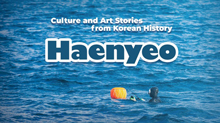 Haenyeo, female divers in Jeju08:52
Haenyeo, female divers in Jeju08:52 -
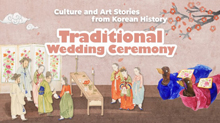 Traditional Wedding Ceremony08:22
Traditional Wedding Ceremony08:22 -
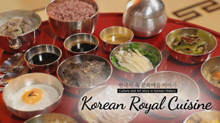 Korean Royal Cuisine08:22
Korean Royal Cuisine08:22 -
 Gat and Traditional Headwear of Korea08:48
Gat and Traditional Headwear of Korea08:48 -
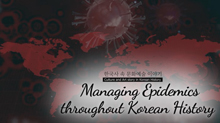 Managing Epidemics throughout Korean History08:48
Managing Epidemics throughout Korean History08:48 -
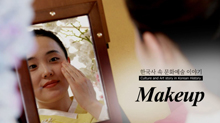 Makeup07:52
Makeup07:52 -
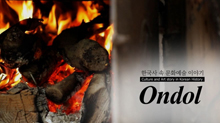 Ondol, Korea's Underfloor Heating System08:40
Ondol, Korea's Underfloor Heating System08:40 -
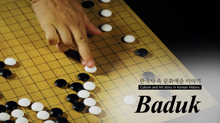 Baduk08:32
Baduk08:32 -
 Four Treasures of the Study09:34
Four Treasures of the Study09:34 -
 Farming Implements09:12
Farming Implements09:12 -
 Coming-of-Age Ceremony08:41
Coming-of-Age Ceremony08:41 -
 Ginseng08:44
Ginseng08:44 -
 Tobacco08:27
Tobacco08:27 -
 Kimchi08:37
Kimchi08:37 -
 Relief Crops08:37
Relief Crops08:37 -
 Korean Currency09:28
Korean Currency09:28 -
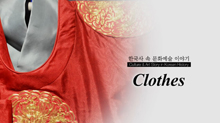 Clothes08:20
Clothes08:20

